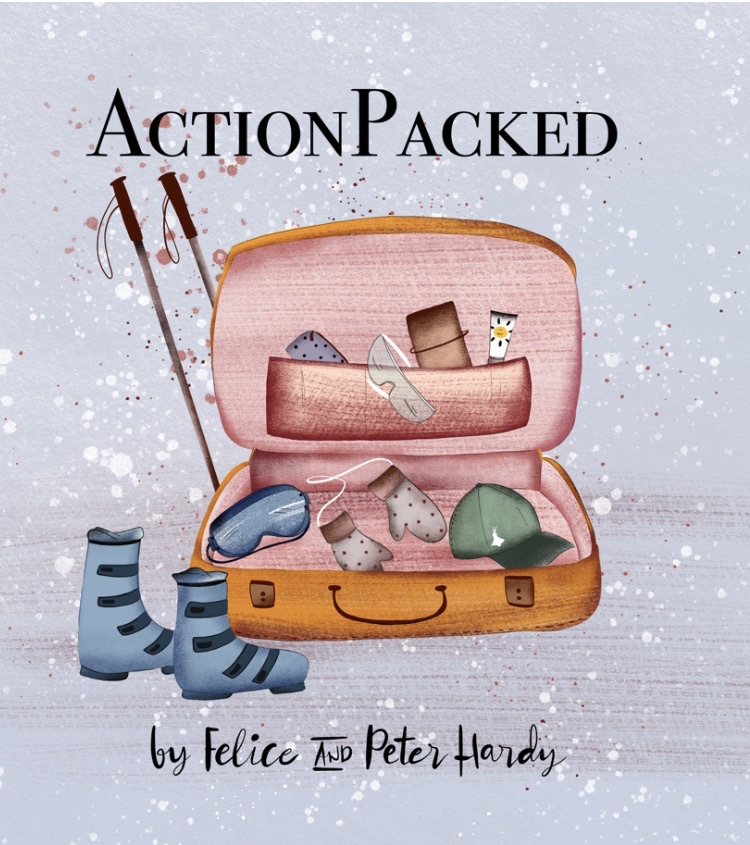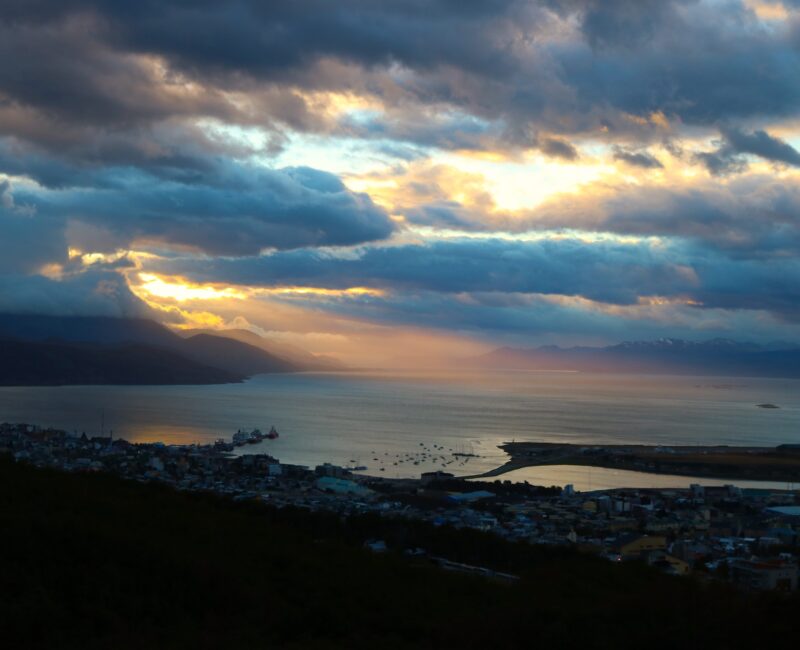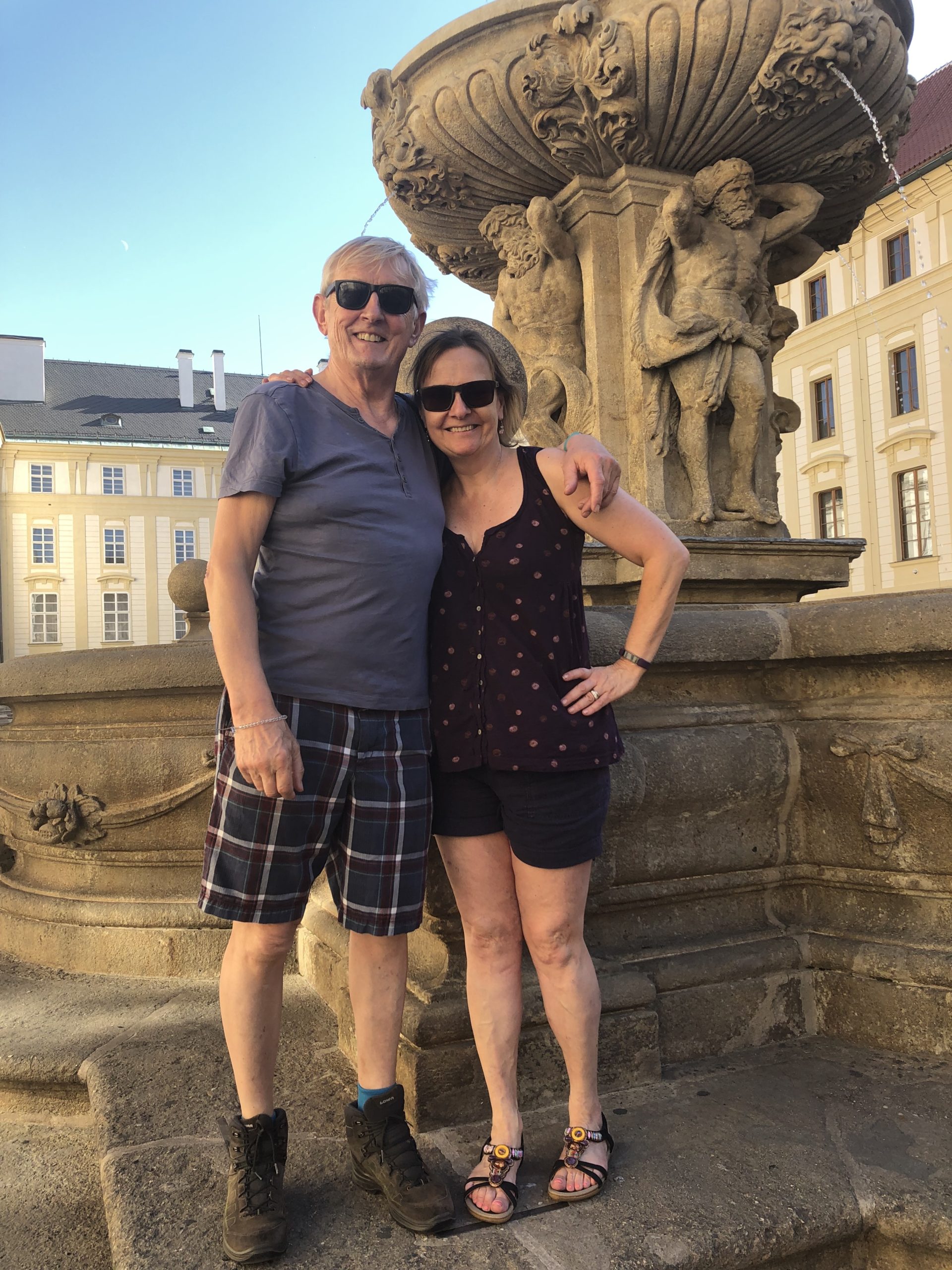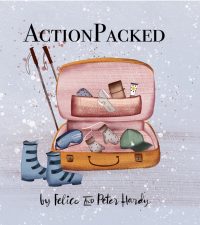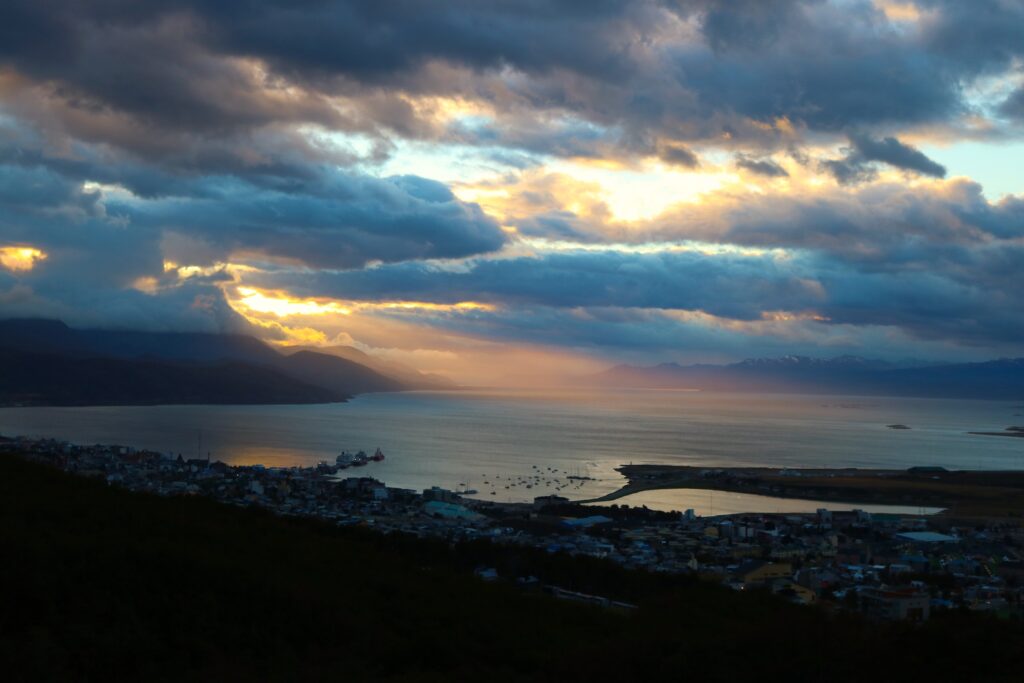
End of the world sunset. Photo: © Paul Lucyk/Unsplash
James I think what Covid has done, especially us all stuck at home, it’s made us think: ‘If I’m going to do it, I ought to get on and do it now.’
Gavin It’s the closest I got to feeling like I was going to die. I mean that.
Peter Welcome to our travel podcast we’re specialist travel writers. And we’ve spent half a lifetime exploring every corner of the world.
Felice We want to share with you some of our extraordinary experiences and the amazing people we’ve met along the way.
Peter This week we’re talking about time and about travel, how to spend our leisure time in this strange, uncharted, Covid world. Now, more than ever, we worry about work, we worry about relationships, about the quality of food and drink we put in our bodies, but we remain startlingly ignorant about how to spend the most precious commodity of all that we have – time.
Felice We’re delighted to have on the show James Wallman, best selling author of Time and How to Spend It. James is a journalist and futurist who says that all the scientific data points to the need to reboot our daily lives and rethink our leisure time. And he’s devised what he calls STORIES, a simple seven-point checklist that tells us how to do it.
Peter James has teamed up with our other guests today, Gavin Copus, business development director of Air Charter Service, a worldwide private aviation operator. Together, they have created Time Well Spent, a series of life-enhancing holidays. The first of these, Journey to the End of the World, takes us to South America. If I could begin with you, Gavin, tell us about Air Charter Service and what it does?
Gavin Absolutely. Of course, we started in 1990 and we’ve grown exponentially throughout the years. And last year obviously was a very bad year for the travel industry, but it was a particularly good year for charter, whether that be cargo charter or private jet charter. So the company is growing now to a 1.2-billion-dollar turnover; we’re a growing company in a pandemic and a growing company in times of turmoil, really. People turn to aviation to solve problems, whether it’s evacuating from typhoons or from nuclear disasters or whether it’s sending aid in to help famine or to help disaster relief. And if there’s something going on in the world then we’re involved. At the moment, we’re very involved in sports charters because sports teams are travelling around in bubbles, so they’re using charter aircraft. The leisure market is increasingly using private jets now because it’s deemed to be Covid-safer, if you like, but it’s also allowing people to get around and do the things they want to do. So if they want to go skiing, for example, if the ski destination is a long way away and it’s quite remote, the private jet will help them get there – as opposed to being restricted to where the scheduled flights are going.
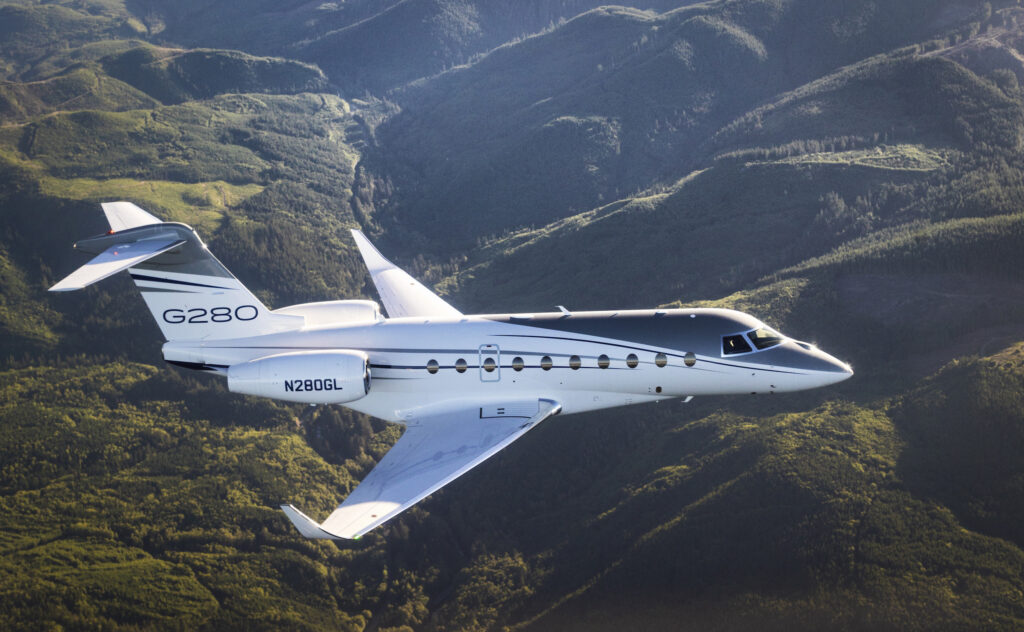
Gulfstream G280 in flight
Peter Now, let’s bring in our other guest today, James Wallman. Now, James, your latest book is called Time and How to Spend It. How does that relate to travel?
James The thing is, where do you think about leisure time, work time, travel time, the most precious resource there is on the planet is the time of individual humans. And whether you’re 12 or 20 or 30 or 40 or wherever you are in your life, it’s going to come to an end at some point. I think one of the things that Covid has done, and I’ve heard this from all sorts of people, it’s made us realise, reminded us of the preciousness of our existence. Too many people, I think have gone: ‘Oh I’ll do that some other time. That will come around.’ I think what Covid has done, especially making us all stuck at home, it’s made us think: ‘If I’m going to do it, I ought to get on and do it now, I ought to use my time well. This is going to come to a close.’
Just what Gavin was mentioning there, just thinking of you guys as ski experts and the idea that you can get where you want to go to by private jet. I just instantly think of the altiport of Courchevel. It would be my dream to land in that altiport and I don’t think you need to be rushed into skiing. I was there before the Russians. It’s the couloirs, the skiing there is magnificent. But I think that’s the point and that’s one of the reasons why Gavin and I worked on this work for ACS and putting together these itineraries was that these guys do time machines, they save you time, they enable you to do other things,
And there’s a fit with the work that I’ve done. My first book, Stuffocation, was about the big trend away from materialism as the dominant value system in our society, to experimentalism. Instead of looking for happiness, identity and status in things, in being the person who wins because you’ve got the biggest car and the most toys, it’s the person who has the most stories and the most interesting stories. And we get status through experiences and the stories that come with those instead. That was really about how to spend money, not stuff experiences. And the next book, Time and How to Spend It, which the FT named the Book of the Year in 2019, the year it came out, just like to mention that because it makes my mum proud – and my dad, who actually reads the FT. That goes beyond the first one is not stuff experiences.
And the next one says: ‘What kind of experiences?’ Because I’ve been interviewed many times on TV, on radio, and people would say to me, ‘Ok, you’re saying spend on experiences. What kind of experiences?’ And truth be told, I don’t know the answer. I love skiing. My wife so-so, she likes the social aspect of skiing, she likes the ice bars. But I wanted to have an answer. So I do what I’ve always done as a researcher – I go find people cleverer than me, places like Oxford and Cambridge and Stanford and MIT and Tokyo University and the London School of Economics and NYU, etc, and I talk to them, find out the research they’ve done, and try and translate that into something practical that a person can use to get more from their time.
Felice So how did you two get together? I mean, how did you meet or think up the idea of doing this together?
James We were introduced by some people at an event I was running for a company called Finn Partners. We were originally introduced by a friend of mine called Debbie, who lives actually around the corner from me. During Covid we would sometimes walk our dogs together – at a healthy distance. And she was telling me about what these guys did in terms of private aviation, what it does for your time. Obviously…well, not obviously, she’s a fan of my work and we talked about how to spend time and I’ve talked to her and her team, about how they can spend their time better, etc. And we thought there was a fit.
She introduced me to Gavin and his team and…well Gavin, you can comment on this. I think it’s been a huge amount of fun working together because we’re similar enough but different enough to compliment each other, to kind of go: ‘Actually Gavin, I would say “I love your ideas, what does that what does that mean for what we do?” And I was also like, “I like what you do. How does that compliment each other?”’
Gavin It’s true because obviously from a private jet point of view, we have to be very practical to a degree, and there’s safety concerns, there’s performance concerns, there’s time concerns, there’s crew duty limitation concerns, a lot of boring stuff to most people. But for us, it’s the bread and butter of what we do. With James in his team, he would come up with an itinerary and it would be the wish list – almost like the dream list. And we’d sit there and go, ‘Wow, yes, that’s amazing. But how can he do that?’ And then that’s when we would take away the problem of doing it with commercial flights, because it’s 100% impossible, and then see how we can make it possible by using the private jet.
James Can I jump in? One of the funny things was when I talked to Gavin and we were looking at the brief, I said, ‘Okay, so are there specific airfields that we should think about? Is there a particular destination?’ And this guys was one of the worst briefs I’ve ever had because he said, ‘No, it’s anywhere. We will make it work.’ If you can imagine when someone said The world, that’s not a brief, it is a brief, but it doesn’t help when I’m trying to explain to my researchers, OK, who are, you know, some great travel writers actually, who I got involved with this. I was given a brief: ‘Go anywhere, but let’s make it really good use of time and we can play.’ Thank you, Gavin, it was a very difficult brief, but it turned into this kind of to and fro.
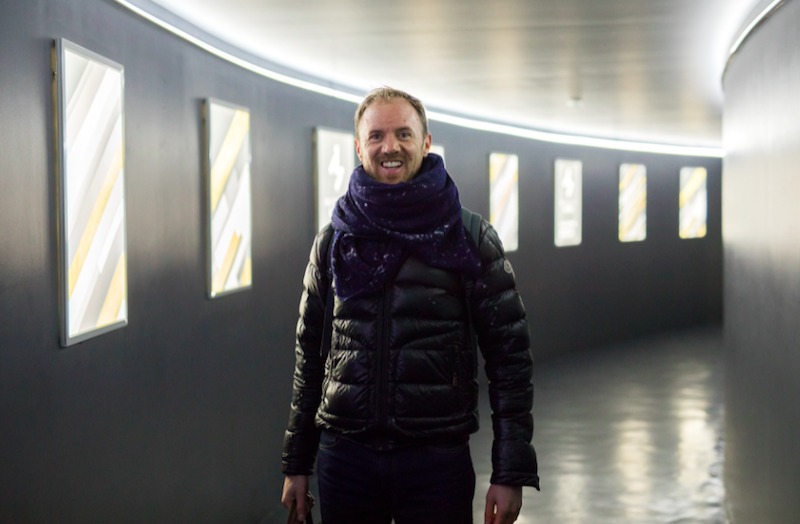
James in Latvia
Peter The first of these journeys is called Journey to the End of the World. Tell us about it. Where does it involve going to?
James How much can you pack into a short amount of time? Because one of the magical things that you get when you fly by private aviation, of course, is you set your own agenda. So then it was kind of ‘OK, so we can save time.’ But I think this is really important, not just about saving time, it’s about creating extra-special moments. The sixth route of the seven rules that you should think about when spending your time is extraordinary. The magic of extraordinary moments – and you can design these in particular ways – is they create the memories that give you…they talk about social capital, it actually will help you live longer because you will have those memories that enrich your life.
It almost works the same way as as money in the bank. Great stories, great memories work in a similar way to money in the bank. The trip that we’ve designed, and it took I think six weeks, eight weeks of to-ing and fro-ing? I mean, once we’d decided on the destinations, the trip begins in Santiago, in Chile. And although I feel awkward seeing saying Chile, talking to British people, I was talking to a friend the other day in the States and he said Chile. So I’m going to stay with it. OK, they don’t say Chile over there. They say Chile. He is opening an office in Santiago, this friend of mine. So it starts in Santiago in Chile. And we start with, I think, something quite simple and maybe obvious. But we start with the idea of a really fabulous lunch in a rooftop restaurant, because the views are spectacular.
The idea is that we meet with a sociologist/Alpinist who would come and talk to the people about this thing they’re about to go and travel along, because the Andes is the central spine, of course, of Latin America, and it’s the central spine of the trip that we’ve designed. So they get a sense of ‘here’s the story. You’re starting on the journey here.’ Then we’d go from there to Colarna..and this is one of the wonderful things: if you fly by commercial jet, you just fly into this place, Colarna. If you fly by private aviation, we can go a slightly different way in and you get to see the largest open copper mine in the world. I mean, it’s an aberration, but it’s also something amazing to see.
I think we wouldn’t push this too much in terms of the structure, but think about the end of the world is a play on the fact that we end up in Ushuaia, the town at the end of the world, and then we go to the Atacama Desert. Beginnings are very important. So when we arrive there, instead of going straight to the hotel, the first place we go to is the Desert of Mars. I remember the colours, I remember the colours in the pictures, and the way you arrive and you go to this place because we’re going to have lunch and I’m going to arrive there late afternoon, early evening as the sun is setting. So the colours are changing in the desert and you get these purples and oranges and reds and it’s a really magical time. That’s important. Then we stay there and it is one of the great places in the world for astro-tourism, which is a really fancy way of saying, looking at stars.
Peter It’s certainly the most remarkable place. When I was 19 years old, I walked across the Atacama Desert because I didn’t actually know what yellow on the map meant. I lived to tell the tale. Almost no water and it was a very strange experience. But I remember one my great memories of that was lying in my sleeping bag at night looking up and there was no artificial light with maybe 500 miles where I was, so you have absolute and complete this amazing view of the stars. And it to me, it’s one of the most magical places.
On the other hand, the memory was the cold, the desert. When you’re in a sleeping bag at 6:00 in the morning watching the sun just begin to come up, praying it would come up quick than it is because it’s so cold. Then, of course, you get that in 10 minutes, you are actually back and you’re boiling again and still thirsty. But certainly it is one of the most remarkable and remote places I’ve ever been to. I would put in my top 10 list of places in the world which are an extraordinary natural phenomenon.
James Fantastic. Oh, you make me feel even happier that we’ve put that right at the beginning. And beginnings are very important. There’s something I call it the B rules; you may have heard of the peak-end rules, but it’s something that psychologists have discovered. It turns out that the beginnings, the extremes and the endings stay in our memories much more than other elements of any kind of trip. So how you design the beginning and how you design the ending, and making sure that there are peaks through the trip, is super-important. So the beginning was very important for us to design properly.
Peter So Gavin, where do you go from there?
Gavin So from there we actually go direct to Easter Island and this is where the private jet element comes into its best really, because you don’t have to go back down to Santiago and connect overnight and then carry on to Easter Island. We just go straight to Easter Island from Calama and we’re able to choose the time of day we want to go. So we’re going, I believe from memory, about 10am. So we’re we’re having an experience in the morning and going to the airport, getting on the plane about 9, 10 o’clock, flying across to Easter Island directly, actually four and a half, five hours’ flight time but you get back two hours with the time difference. So you’re arriving in the afternoon and then you’ve got all afternoon and evening to then enjoy Easter Island.
James We’re then going to leave the next morning, because I think the thing about Easter Island is that remote places are wonderful and it is magical for that, but the thing that’s there is those Moai – that’s the thing to see. So the magic is, we’d see them in the afternoon. There’s one particular place where they it’s amazing to see them in the morning at dawn, and then we’d have breakfast and go. So, again, coming back to this idea of extraordinary moments, let’s not eke the trip to Easter Island beyond what it should be: go there, see the thing, move on for more spectacular stuff.
Felice James, will you be accompanying these trips?
James I am hoping so. I haven’t been anywhere – and same as you, travel has been a very large part of my life and I miss it, but yes, I’m hoping so. But it’s not necessary for that to happen, sadly. But actually the same as you, Peter and Felice – and I think what Gavin was saying there about how he’d been planning his trip, but then he was planning for other people – once you enjoy travel, the vicarious joy of organising someone else’s trip and when you’re writing a travel article, I just find it so much fun. You’re thinking about these other places. Obviously, it’s best when you actually get to go there, but the thrill of other people, and setting up and designing it for other people…that’s quite powerful too, surprisingly powerful.
Peter Gavin, is there a danger here that it is all going to be a bit rushed, that you and you can see Easter Island, you see the statues, you go to bed, you get up, you get on a plane again? Is that all a part of the experience, a good idea to pack in so much in what is a two-week program?
Gavin Yes, I think so, and really, because time is something that high net-worths who are able to afford this sort of trip, don’t have much of. So they are able to do this two-week trip in the time it would probably take normally at least a month, maybe six weeks. And a lot of that time is spent, as I mentioned, connecting through airports like Santiago or spending a night in a hotel they you don’t want to really want to be in. Seeing things that are important is where the memory comes; that’s part of what James is saying. Your memory of this trip will be so far-reaching, you won’t realise it was only two weeks. You’ll look back on it and it in your memory it could have been two months even, because you’ve crammed and experienced so much.
If you needed the rest time and you needed the downtime, it’s there. It’s just not an itinerary that we’re saying has to be two weeks. So if somebody said, ‘To be honest, I want to have two nights in Easter Island because I actually want to take it in, makes you want to have a little bit of downtime.’ That’s fine, we just extend it out by day. These itineraries are very much personal and bespoke. It’s giving the customer and the actual passengers an idea of what’s possible and of course, they can do it exactly. But if they feel they need a little bit more time somewhere, that’s absolutely fine.
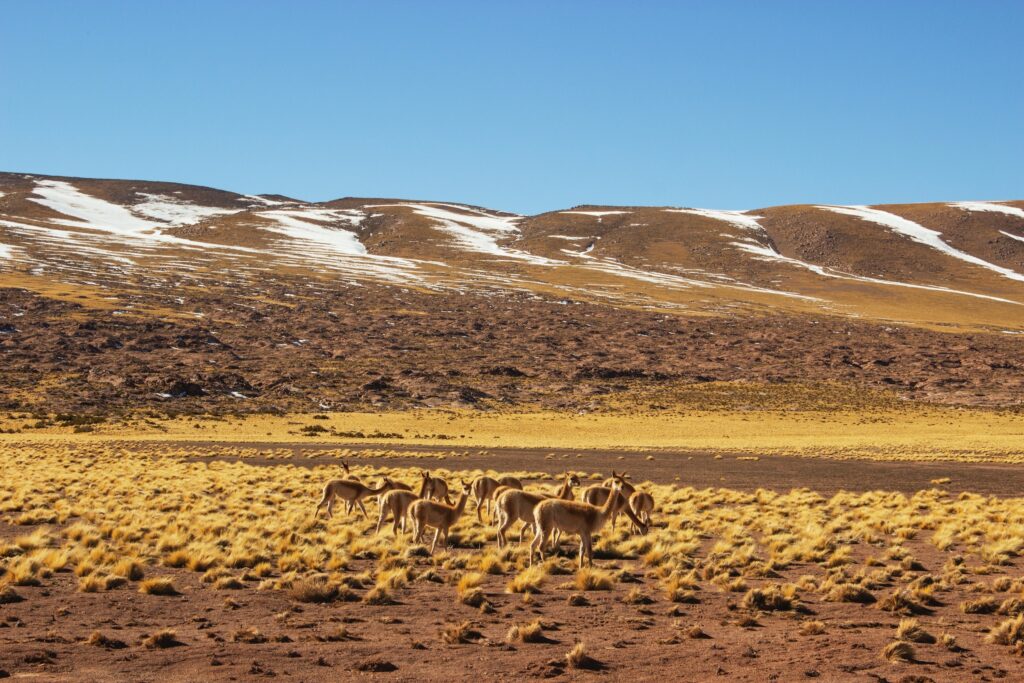
Atacama Desert. Photo: © Fernando Rodrigues/Unsplash
James Can I jump in with a few comments on this, if that’s OK? I am not pro tick-box tourism at all; I think that denigrates the magic of going places. I’m part of something called the Transformational Travel Council and there was a line from a colleague who’s involved this who says: ‘One of the lies of travel is that people go so far to feel so little.’ This trip, the way we designed it, I think Gavin your point there is to illustrate what is possible at the same time, although if you just look at it, it looks like there’s a lot going on.
We have also deliberately designed into each part of the trip the downtime that’s required. So in each of the stages…we’ve not gone through the whole trip because there’s lots of different episodes. If you think about the way that a TV show works, you have each episode is the full story; it’s not like a movie. And we’ve designed each part when it’s in San Pedro, the Atacama, Easter Island.
Peter After Easter Island, what’s the next stop?
Gavin Basically, we leave there and again, we go direct to our destination as opposed to going back via Santiago. Because Santiago to Easter Island is the only commercial route available. So we fly from there straight to Temuco, which is the airport for Pucón. Then it’s a helicopter transfer to the resort hotel in Pucón. It is an experience destination. I don’t know if you’ve been to Pucón before, but you can do so many different activities. In this particular itinerary, we’ve chosen the volcano.
James You could see these boulders are cascades.
Peter I think you’re very interested in particular, in spending as much time outside as possible hiking or climbing or walking or skiing or whatever, because that enhances happiness, you feel? Therefore, in this case, this is that part of it. You’re going to see a live volcano and you’re going to walk up to it, right?
James Yes. Just to be really clear, it’s not that I feel that being outside makes us happy; it’s the data that says it makes us happy. And although I often present these things in that way, it’s all backed up by research, by scientists. So the research is very clear: if you want to be happier, spend more time outside, and this trip ticks that box so many times in so many different ways.
I’m going to flag up something also from what psychologists call ‘duration neglect.’ This is where people tend to forget how long things take; they remember particular moments. If you think about a trip to Disney is a really good example: you tend to remember the three-four-week kind of highlight moments; you forget the two and a half hours you sit in a line. So that’s the way we remember things, which is why this trip packs in. You know, if you think about Peter, when you crossed the Atacama Desert…and well done by the way, that’s cool. There are different ways to see these places. And if you’re the resource that is and you probably went when you had more time than money. So there are different ways to go to Latin America. One way is when you have more time and less money, and that is to take the time and go backpacking. And when the thing that you have is less time and more money, there’s another way to go see it.
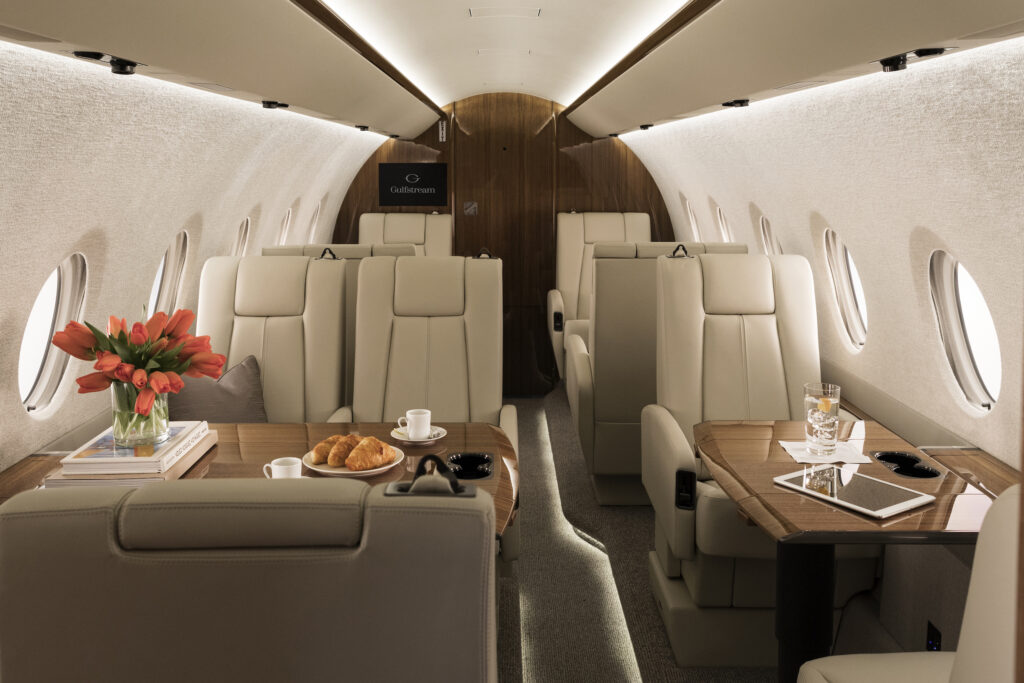
Inside the Gulfstream G280
I don’t think this trip is designed to tick these places off. It’s just to have special moments with…I think the plane that you looked at Gavin takes is eight comfortably, it seats 10, but takes eight comfortably with people who are super-close to you and creating memories. one of the places that we go to is in the wine lands of Chile. The hotel is this place called Viñya Vik. It looks like something designed by Frank Gehry. It’s pretty spectacular and the wines, of course, are fabulous. It’s designed specifically in terms of the time design, in terms of the itinerary design, for the time where you just chill and take it easy. Very different, it is a different stage of the trip to Pucón.
In Pucón we chose that hotel deliberately because you can land there in the helicopter. The hotel is within the national park, so you don’t need to waste time going in and out of national park – you’re there. The view from your hotel room is of the volcano, so you get the magical view. But you get this as you get up there, there’s the volcano. You get the anticipation that we’re going to climb up. And Gavin, would you like to tell a story of why you climbed up that? Because I like hearing the story.
Gavin So I thought, ‘Oh, this is just going to be a hike up a mountain,’ but it was obviously declared as an active volcano; you can see the venting from the top of the volcano. So a three hours, three and a half hour hike up the top with a guide and maybe two or ten people. And there’s a sort of like a chain of people climbing the mountain and you go through a valley and you go left to right as you as you climb up. And they didn’t say anything about the volcano being dangerous. They just said it was live, active. We’re halfway up, we’re really tired, we’re really getting into the groove, and I just happened to look up at the volcano just to see the venting. As I did, I witnessed half of the wall of the volcano collapse, and as it started collapsing I shouted: ‘Boulders! Boulders!’
The guide looked round to me and he was in horror and he just said: ‘Everyone to the side!’ We had to literally rush to the side of this valley, and you could see these boulders cascading down the volcano. In particular, one of them was the size of a car and another one was the size of a fridge. The size of the car boulder just came at me and it landed probably about 200 metres away with a sort of splash of snow. The fridge-sized one continued to bounce like the bouncing bomb coming towards you. I was off to the side and it landed about 100 metres away just with a big splash. You could see all the way up the volcano, the 200 people or so that were climbing, all rushing off to the side and everyone survived. But it was a spectacular event and we didn’t have GoPros in those days, we just had cameras that we had stashed away because we were climbing, and ice picks. That was just a tourist climbing a mountain and I almost died.
Peter Well, I guess that that reaches a large tick on your checklist, James
James Oh, absolutely. The I of STORIES is about intensity, which is about flow, which is about being in the moment, it is the sort of thing that you get when you’re skiing down a hill and you may or may not fall over, it’s the feeling you get when you’re playing tennis. And it can be the feeling you get when you’re really enjoying a wine and, you know, you can get from sensory things as well but you need to be engrossed in the moment. When you’re doing something that’s difficult…so there are stages to the flow.
The neuroscience of flow is very interesting. And so the first thing you need is some kind of struggle, something that’s challenging, something that pulls you in, which is why it’s hard to get flow from a lot of daily life, because a lot of daily life in the modern world is designed to be super-simple and easy for us. So it’s important when you’re designing any kind of time that you spend or a travel itinerary, that you build into it something that’s challenging. Too many people think, ‘Oh, we’ll get away, we’ll go and sit on the beach or we’ll just sit and do,’ and I think more and more of us are realising that A you get no story from that and B, you think about deadlines and you think about the work that you haven’t done and you think about all those things. But when you’re in the moment and boulders the size of fridges and boulders the size of cars, or even you’re just hiking up a hill and it’s a challenge, you know, sorry, a mountain, and it’s challenging for you that’s great to get you into flow.
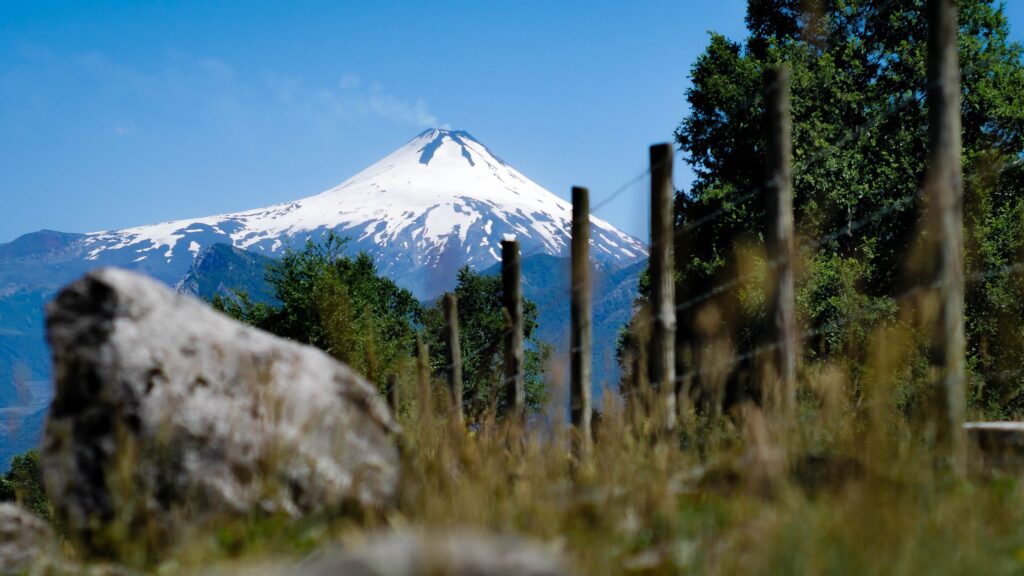
Vilarica volcano, Pucon. Photo: © Diego Marin/Unsplash
Flow is crucial not just for happiness in the moment, but actually…this is interesting, I think…for curiosity and creativity. I talked to a fantastic guy the other day in Colorado who is sharing with me that there’s a difference between hedonic and eudaimonic happiness hedonic. Is there a headiness and you get from drinking or whatever? Research shows that a few drinks do make us happy but of course, the research also shows that you don’t feel so good the next day or whatever. But eudaimonia is that idea from Aristotle, the philosopher – eu is good, the diamonia is your spirit, and to get to it, lots of modern psychologists would talk about enduring happiness, the long-term happiness. The way to get to enduring happiness is through things that are quite challenging, that are quite ultimately satisfying, but often hard at the time, hard in the moment. This is about life satisfaction.
Interestingly, and this is why more governments should get interested in this as well, is hedonic happiness reduces our curiosity and creativity, eudaimonic happiness, like some of the things we’ve designed into this trip, increases your creativity and curiosity. So if you’re a kind of person who wants to get more from life and be better at what you do, and I think a lot of people…so this idea of a functional alibhi has also been shown by people…I think it’s researchers at Harvard and maybe University of British Columbia in the States…functional alibhi can be really useful for people. Too many of us work too hard nowadays, but when you know that your time off is going to make you better in the thing that you do, the thing that makes life work, makes you a good parent, makes you good at your work and frankly, good at life – you should choose the kind of experiences that lead to eudaimonic happiness, the challenging stuff, walking up this volcano for example.
Felice That brings me to the question of can you tell us a bit about your philosophy and your STORIES checklist? Because I don’t think we’ve gone through what each letter stands for.
James Yes, sorry. That’s because I often wander and forgive me for doing that. I’ll try and keep it as brief as possible. It took me about three months to come up with the STORIES checklist; it sounds kind of glib, but I wanted to find out what the experts have discovered and put into something as handy for us – hence Stories checklist.
So the first S is the story. So stories have a magic that connects us to other people and relationships make us happy. So all the stories are all connected and they support each other as well. So when you tell a story to somebody else, it’s one of the reasons why experiences are better than material goods to make us happy. If someone says to you, ‘Can I tell you about my new sofa?’ Yeah. But if someone says: ‘Can I tell you about my weekend?’ that’s more interesting. Or they say, ‘Can I tell you about the time I went to Glastonbury and it rained for three days or the time I went to somewhere and something challenging happened or, I’ve got this problem at work,’ that’s interesting. It is the kind of story, there’s a particular type of story that we should tell. It’s the hero’s journey and the hero’s journey is rom a certain point of view, it follows the same shape as that neuroscience of flow.
You need the challenge you need something to kind of put you into ‘This is challenging. This is difficult. I’m focusing here,’ and then things turn out ok in the end. A great example is Cinderella. There’s Cinderella. If she just been a girl who married a prince, there’s no story. She needs for her mum to die, for her dad to remarry. She needs for her dad to die so she’s stuck with the awful stepmother. She needs to be the girl locked in the cupboard and then she meets the prince, etc. It’s the same with Star Wars; it’s the same with the story of Moana, it’s that movie 1917, but it’s also the stories that we like to hear.
The great leaders, not just at our age, but of any age, tell stories that go like this. ‘Things are tough now, but come with me and we’ll make it to the promised land. Things will get better, but we have to go through that challenge.’ And so therefore, when you think about the time that you design for yourself, don’t fool yourself for sitting on a sun lounger is fun. Don’t fool yourself that you should have a great weekend. Don’t just think: ‘Let’s have a pleasant time.’ Go through those challenges and build that into your time and realise that that’s where the gold of life is. That will make you feel alive, fully alive, and it will give you stories to tell other people that will make you happier.
Peter Then briefly run through the other parts of STORIES?
James T is for Transformation, which is about change, development, growth and super-important to be happy. O is Outside and Offline: put your phone down, be in the moment. You know, the more time you spend online is, the more time you’re not spending with other people. And the data is very clear on this.
R is Relationships. The Harvard Adult Development Study, which has been running since 1939, one of the longest longitudinal studies that there is, shows very clearly the people that have the connections, the relationships, are the people who live longest and they have the best time. So we are a hyper social species.
The I is Intensity. Intensity is about flow. It’s about being in the moment. It’s about trying to do a good job. It’s trying to stay on your feet when you’re skiing, is trying not to hit your boat when you’re sailing, it’s to climb a mountain and not get hit by boulders.
The E is for extraordinary – there’s a weird one here. Ordinary moments make us really happy too. You think of the joy…and I am very English here – have a nice cup of tea. You know, when you’re traveling and you’re in the States or in France and they bring you the tea and they’ve got the tea bag on the side, you’re like, ‘No, no, no, you put it in when the water’s hot. Not now, you know.’ But that’s ok, because when you come home, you have a proper cup of tea. So ordinary things make us happy, but so do extraordinary things.
I think of this, I hope you’ll excuse this, but it’s almost like the night sky. You need the dark to see the stars. For Christmas Day to work you need the other days to not be Christmas Day. You can think of chiaroscuro, the painting – you need the dark with the light. So you need the ordinary and enjoy that, and then the extraordinary…create these moments in life that we remember. So therefore, design your itinerary, design your time away where you had those moments. One of the wonderful things this does for people is when you’re confronted with ‘Oh that’s a bit expensive, I’m not sure if we should do this,’ it gives you an excuse. Don’t save it so you can buy that stuff you don’t need. You’ve got enough clothes. Spend it on the experience.
I’ve used this myself. I had a woman who contacted me on Facebook who said that she always goes to the same place every year but having read Time and How to Spend It, she did a couple of things with her teenage kids…and of course, we all know how hard they are to entertain…and because they went for it, it turned into the best summer and they remember it specifically.
The final S is Status and Significance. And this is a slightly weird one, because it’s very awkward for people, but more status makes you live longer: you get a more attractive partner, people laugh at your jokes more, but you live longer. It’s like eating greens, it is really good for us. But status on its own could be very lonely. Super success when you don’t bring other people with you is rubbish – Oprah Winfrey is a sterling example. And actually to say sterling like like Raheem Sterling, the footballer, you bring other people. It’s not about you, it’s about us.
Actually let’s come back to the hyper-social species borrowed from Aristotle. If you look at his Nicomachean Ethics, which was put down by about 1500 years ago, 1400, 1500 years ago now – when you want to be happy, you need to give to others. You can see this in the work on kindness, but this is where significance is really important. We built this into this trip because there is a meeting that we don’t know where it will happen because it needs to work around the Tomkins Foundation. So the woman who runs it, formerly the CEO of Patagonia…and the idea is we’ll get a chance to meet her, to appreciate this wonderful part of the world and have an opportunity to contribute.
Contribution makes us really happy and we feel part of something; we live longer from it. So if you bring this story stuff together and you use it in your daily life, in your work life, in your leisure time and in your trips, you can’t help but increase it. You know, there’s no silver bullet but it increases your chances of being happy, better relationships, better stories, better memories and being more resilient.
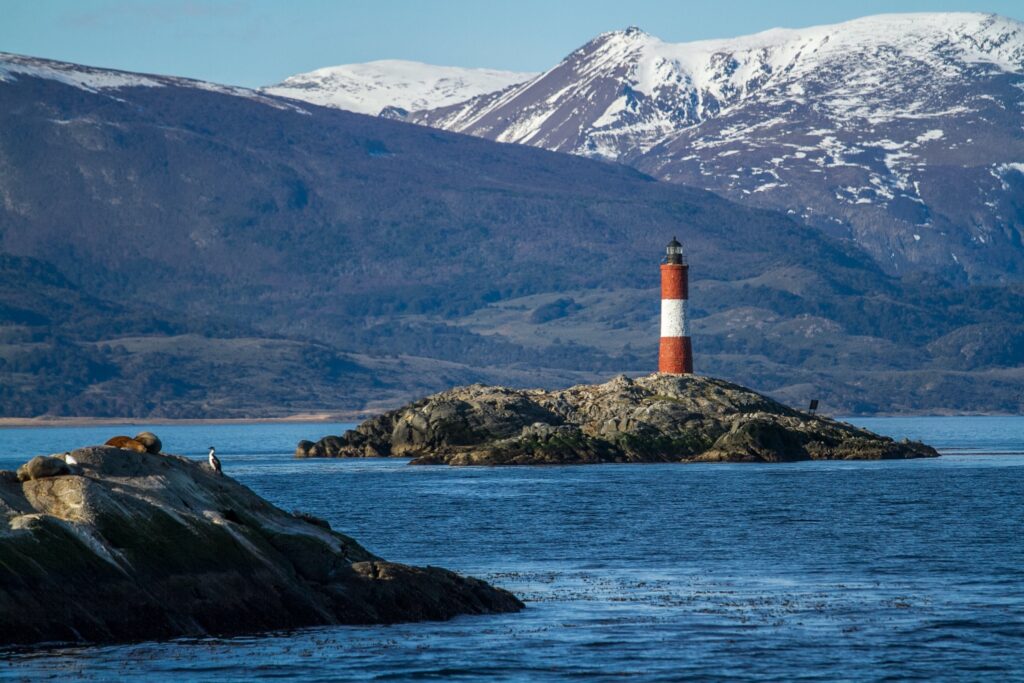
Ushuia. Photo: (c) Dennis Fidalgo/Unsplash
Peter So Gavin, having survived the boulders and then moved on from there, where do we go next, where can we possibly fly from there?
Gavin So we thought, ‘Well, where do we go next?’ And obviously Ushuaia, which is where we got the Journey to the End of The World from, that’s what it’s called. It’s called End of the World. So we thought we’d go down to there. Temuco is in Chile and obviously Ushuaia is Argentina, so there are no direct flights again between those two towns. So using the private jet allows us to, again, decide what time we want to go and, more importantly, what time we want to arrive. By flying down the Andes with the Andes off the port window, we can depart so that we arrive just before sunset.
So the sun is setting off our right-hand wing and we’re looking out of the port window at the Andes with the setting sun, sort of literally just lighting them up. We do that all the way down to, about two hours or so, down to Ushuaia. And as we land in Ushuaia, the sun is just setting over the right hand side and then we spend a few days in Ushuaia.
Felice Now, I’ve got to ask you something, Gavin, about the environment and flying, because obviously flying doesn’t have a very good reputation.
Gavin Yes, well, we do cover that. As a company we have a carbon offsetting scheme at the moment. Unfortunately, there is no solution for cars to electric and hydrogen aircraft. They are stuck with fossil fuels at the moment. Sustainability will come in, so there will be sustainable fuels that are being developed and they are being used in commercial aircraft as tests at the moment. So eventually it will improve and we don’t know whether in the future aircraft will be electric, hydrogen or something else. It might be that it’s sustainable fuel for a while before moving to the next step.
So our clients are able to offset that carbon and we have an offset scheme, which is a percentage of the total price. And those carbon credits go against various schemes that we deem important. It’s a way of acknowledging that private aviation is not necessarily the greenest thing to do.
Peter So where do we go from Ushuaia?
Gavin OK, so after Ushuaia we spend again a little bit of time in Ushuaia…I believe it was just one night because, again, it’s being there which is the exciting thing and we do a few things there. After that we decided that we wanted, if we could, to take in the Perito Moreno glacier, but we couldn’t really fly direct to the Perito Moreno glacier in El Califate because we are using a Chilean aircraft and we couldn’t fly domestically in Argentina. So we thought, OK, let’s take it to the Torres del Paine National Park. So we fly to Pueno Natales and again, that’s a very short, quick flight and not easily done commercially.
There was talk of maybe doing puma tracking. So you go out into the wilderness and you’re looking for this elusive creature that is in that region, but that’s sort of four or five days and not everyone has that time. So we just went for the traditional tourist, the national park experiences and from then we then head back up to Santiago. But interestingly, we’re able to take in the Perito Moreno glacier just in the same day we’re travelling up to Santiago. So we cross the border by jet into El Califate in Argentina, off the jet, transfer to Perito Moreno glacier, see that fantastic site for three or four hours, return back to the aircraft. And then we continue on to Santiago, arriving there in the early evening.
Peter And is that the end of the trip?
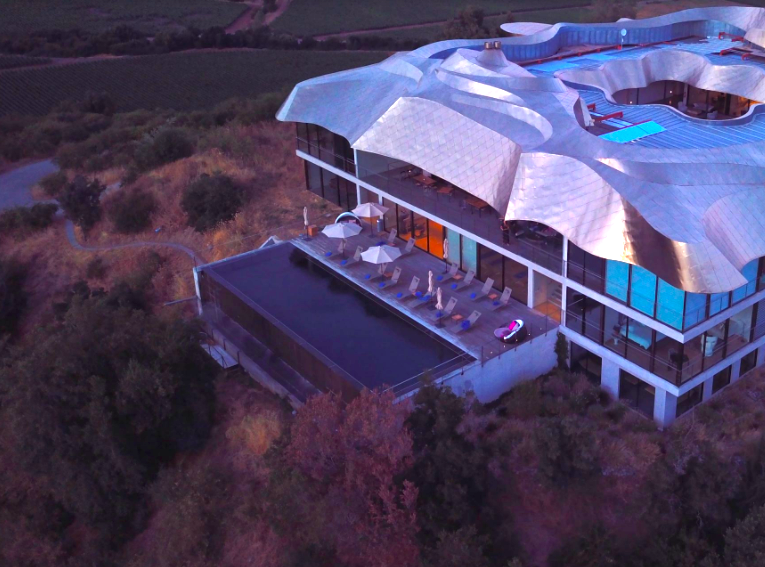
Viñya Vik, Chile
Gavin Then we are in Santiago and we go down to Viñya Vik, which James mentioned earlier, which is the sort of the reflection part of this this whole journey. So we are looking at Viñya Vik as a sort of reflection, but also as a way of bringing us back to where we started from…but not quite, because then, James, maybe you want to explain the part after the vino vic when we head off to the salt flats and the reason behind using the salt flats?
James We designed the salt flats. If we go back to the idea of the B rules and the importance of extraordinary and the importance of beginnings and endings. So it’s worth pointing out that we played with this a lot because we wanted to make sure the ending was special, but it also felt different to the other parts. If we think about the hero’s journey and the idea of you go up and something challenging, then you come down the other side – it was very important and this was had a different energy feel to it. You know, this isn’t climbing a volcano, whilst it’s also spectacular I mean, it really is. So the salt flats where Peter you’ve possibly been?
Felice I’ve been to Argentina to the salt flats, which are very close to the border with Bolivia, so almost the same.
James Spectacular views, wonderful pictures, it feels like it goes on forever. The sky and everything look. And also also some astro-tourism as well. So we were very conscious of the fact that this would be a spectacular ending. The places we’ve got to set up to stay would be in these geodesic domes or in one of those wonderful aluminium trailers, either an Airstream or a geodesic dome, depending on the people. We also looked at a salt hotel, but quite frankly that’s more gimmicky than the other two.
You’d have something absolutely spectacular as your final kind of landing place and the last thing that you did on the trip, that would be super-memorable to make sure this really stays in your mind. But at the same time, there’s a reference to San Pedro de Atacama…so there’s a framing here as well. And if you think about great movies and great stories, it’s really nice to have at the beginning and in the end to have a certain kind of frame to them as well. So it would bring people back to where they began.
So they start to think about themselves and how they’ve changed, because then when we fly back in to Santiago de Chile for the final bit, we would meet with the same person again and either go to the same restaurant or another rooftop restaurant with a view yet again of the Andes to reflect on the whole trip again, reflect on themselves, about what they’ve seen and what they’ve done and how they’ve changed, bringing them to the same kind of place.
And there’s an element here, and I hope you’ll see this – the beginnings and the endings are also, in terms of the structure of a story as you cross the threshold from the old world, the normal world into the world of the adventure. And then you cross back again and you can see this is just one step or you can see this as steps.
I went to an experience very well-designed recently at the Royal Opera House, where they designed different steps into the experience, so that when you arrive of course you’ve got the noise and the bustle of London and the rain – but you need to be in the experience. And we’ve designed this trip deliberately to take people away from normal life and in, so we arrive in the capital in Santiago and we have this opportunity to think about what we’re going to set the story up. Of course, we’re travelling by private jet, so each moment you’re going to have a chance to reflect through. And then we arrive in San Pedro de Atacama and we’re crossing into the adventure, and on the way back we’re doing this through steps as well, enabling the person to really be in the adventure, appreciate the adventure for what it is, and then come through the other side and reflect on the transformation that’s happened within them.
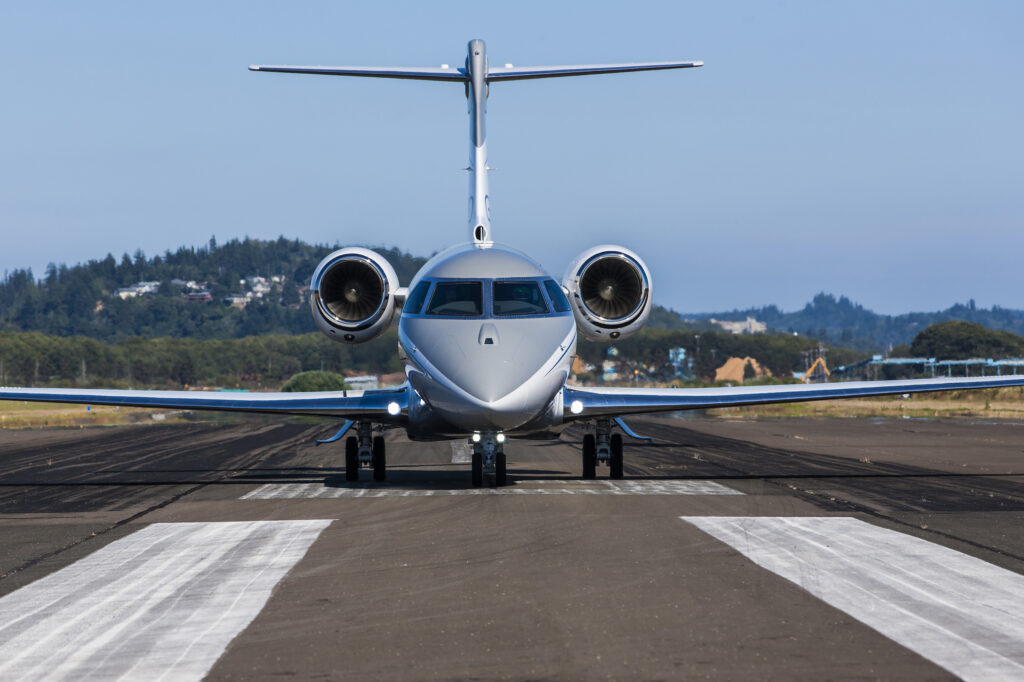
Gulfstream G280 on the ground
Peter So Gavin, presumably none of this would be possible to go by a scheduled airline? Well, it would take many hundreds of hours.
Gavin We worked out that doing this by private jet is 23 hours of flying. Looking at the commercial options, if indeed you would actually take a commercial flight between some of the cities, most of it you would probably just do 24-hour overground, but it’s 163 hours by commercial. That’s not taking in the stopovers, the connections, the multiple flights, the border crossings, and of course, at the moment, you want to avoid as many border crossings as possible by commercial because of the delays getting through the borders themselves.
I mean, at the end here, we’re talking about the salt flats in in Bolivia. We fly from Santiago directly into Uyuni, which is right on the salt flats. Now, commercially, you can’t fly between those two cities, you have to go via La Paz or you have to go to Santa Cruz and the schedules just don’t quite add up. So therefore, if you want to go just for a few days, you might have to stay a week because you can’t fly in, fly out two days later and you’ve got to fly via these two airports and you’ve got to stay overnight.
James So that business is just the schlep of doing it.
Gavin It’s fun if you’re a backpacker and you’re part of this part of the experience and you get on a 12-hour coach journey and then you have to go where you want to go via…
James We’ve all been on those trips. They are fun, right?
Gavin They are really fun when you’ve got the time. I think that’s right..
Peter So at the end of all that, James, you’ve got a story, you feel a hero and you’ve got something that’s enriching your life and enhancing your life, changing your life in every possible way. You’ve certainly got something to tell people at the dinner table when you get back home.
James I think you’ve got something that tells you who you are. I would agree, tells you who you are. I think it’s worth pointing out and I think Gavin put it out pretty well there, you know, I’ve been on the 36-hour train journey across India. There’s a time and a place in your life to do those things. If the resource that you are pouring is money, then do the 24-hour coach trip, because it’s also a great experience and horrific and amazing and, you know, you get a story.
If the resource is your challenge is time and you have the resources to go by private aviation, that’s the choice to make. And I think this is one for me, a really interesting statistic from these guys at ACS that only 10% of people who can afford to fly by private aviation do so. And that to me, obviously, my work in time and how to spend it…there’s a new book that’s just come out called Time and How to Use It…the thing that bothered us in the 2010s, and rightly so, was are we spending our money correctly?
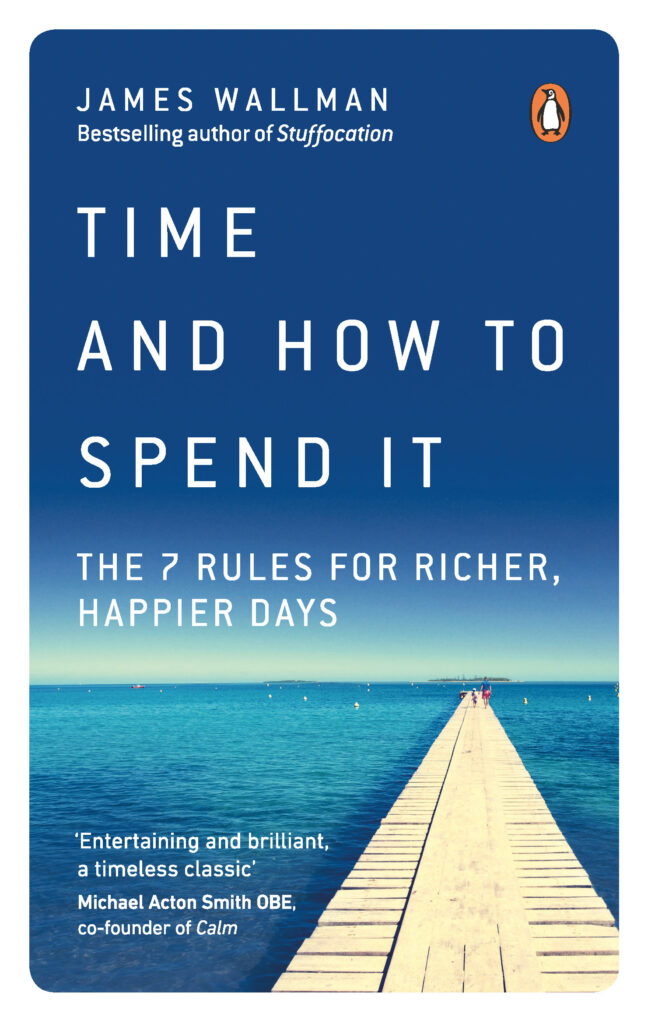
James Because of Covid this has turned up the volume on where we are in terms of the evolution of our culture. But we live in a wealthy country and the thing that we can’t get more of, you can always go get more money, but you can’t get more time. We have our 40,000 weeks. We need to get the most from it. So if that’s your resource, it’s tight and you’ve got the money, you should treat yourself to the experiences that there are in the world.
I’m not the third richest man in the world, but I wouldn’t mind a bit more time as well. You but you know, you can exercise, you can eat green vegetables and you should exercise and you should eat green vegetables and you can stretch a bit. But the key is, you know, what you do with your time matters, right? If you live a shorter life, but you do something. I don’t want to quote Mussolini, which is ‘It’s better to live a day as a lion than 100 years as a sheep’ – I don’t agree with that. But you should approach your existence, because it’s short and it’s precious, as how can I get the most out of this? I want to have fun here. This is my go.
How we spend our time and especially as Covid has made us go, it’s a bit like being in a sort of very fancy prison. But when you come out and like, wow, I want you to think about what a prisoner does on their first day out. They go out for dinner, they see their friends, they do something that’s meaningful…and I think we’ve got millions of people who are and you see in the data as well, who are itching to get out, to go see, to go do.
Peter James and Gavin, thank you very much indeed for appearing on the show and if you’ve got a spare seat or two seats…
Gavin You’re welcome to join.
Peter How do people book?
Gavin You go to our website, which is Aircharterservice.com and all of the information on whatever aircraft you want to charter, whatever part of the world is available, through our website.
Felice James, if people want to buy your books or find out more about you, do you have a website?
James Jameswallman.com – I run something called the World Experience Organisation, which is Worldxo.org, which is about experiences in the experience economy, where the simplest thing is to to buy the book in your local bookstore or on Amazon – Stuffocation and Time and How to Spend It – in order to spend better time. But if you even look up on the Air Charter Service website, you’ll get a sense of the ideas from looking at this itinerary.
Peter We wish you the very best of luck with it. So there you have it. Journey to the End of the World is the first of a series of ultimate holidays designed by Air Charter Service in its Time Well Spent series, the costs. Well, there are so many variable factors on the trip, but the starting point is around 50,000 US dollars per person.
Felice That’s all for now. If you’ve enjoyed the show, please share this episode with at least one other person! Do also subscribe on Spotify, i-Tunes or any of the many podcast providers – where you can give us a rating. You can subscribe on Spotify, Apple Podcasts or any of the many podcast platforms. You can also find us on Twitter, Facebook and Instagram. We’d love you to sign up for our regular emails to [email protected]
© ActionPacked Travel
![]()
- Join over a hundred thousand podcasters already using Buzzsprout to get their message out to the world.
- Following the link lets Buzzsprout know we sent you, gets you a $20 Amazon gift card if you sign up for a paid plan, and helps support our show.
